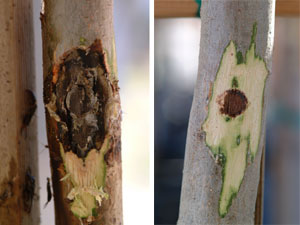New treatment for Sudden Oak Death approved
Berkeley plant pathologist finds that phosphite compound doesn’t kill key pathogen, but inhibits its growth. Innovative treatment-delivery method “comparable to time-release” drug patch for humans
![]()
| 08 October 2003
| |  At far left, an untreated oak sapling eight weeks after being infected with the Sudden Oak Death pathogen. At near left, an oak sapling treated with Agri-Fos, a commercial treatment, and then inoculated eight days later with the Sudden Oak Death pathogen. After eight weeks, the inoculation wound is still present, but the treatment has prevented the pathogen from growing. Photos courtesy of Matteo Garbelotto |
State regulators last week opened the door for a treatment for Sudden Oak Death to be legally applied to oaks and tanoaks. A UC Berkeley researcher has proven the treatment effective in preventing or slowing down infection, and developed an innovative technique to make it significantly easier to administer.
The Department of Pesticide Regulation approved a special registration for this treatment on a fast-tracked, special-needs basis. It is the first and only treatment approved by the state for use against a pathogen that has killed tens of thousands of coastal oak trees from California’s Big Sur to the border of Oregon.
“The likely areas where the treatment would be used include mostly private-owned land, but trees around high-use facilities in public parks may also be potential candidates,” says Matteo Garbelotto, an adjunct assistant professor of ecosystem sciences and cooperative extension specialist at the College of Natural Resources. “It’s really meant for individual oaks or tanoaks that are at high risk for infection, such as those in the vicinity of infected California bay laurel trees.” In the wild, California bay laurel trees are considered the most important vector for spreading Sudden Oak Death. Spores congregate on the leaves of those trees, where they can easily become airborne.
Garbelotto and David Rizzo, associate professor of plant pathology at UC Davis, first identified Phytophthora ramorum three years ago as the fungus-like pathogen responsible for Sudden Oak Death. Since the disease was first observed in Marin County in 1994, it has spread to 12 California counties, including Alameda and Contra Costa, and it has been confirmed in at least 25 different plant species, including California bay laurels and rhododendrons. It has also been found in nurseries in Washington state and British Columbia.
Not a cure-all
The treatment is a phosphite compound, sold under the brand name Agri-Fos, that has been effective when used on other Phytophthora species. Garbelotto, the first to test it on P. ramorum, emphasizes that the treatment is not a cure-all, saying there is no evidence to show that it would be recommended on a widespread basis. The treatment has not been tested on other plant and tree species susceptible to Sudden Oak Death.
The confirmation last year that redwood and Douglas fir — two of the state’s most highly prized trees — were susceptible to P. ramorum sparked concerns about the pathogen’s ability to do more damage. But it is the state’s oak trees that have suffered the most dramatic impact, exhibiting oozing lesions and cankers as they die.
To test whether Agri-Fos worked on diseased trees, Garbelotto infected potted oaks and tanoaks with P. ramorum, then waited several days to several weeks before injecting the phosphite compound. The injections slowed down the growth of cankers on treated trees.
Not surprisingly, he found that the effectiveness of the treatment declines steadily the longer the tree has been infected. “Ideally, this would be used as soon as symptoms are noted,” says Garbelotto. “The treatment is not recommended if the symptoms have been around for a year or more.”
The treatment does not kill the pathogen, but stops its growth if used in the early stages of infection. Garbelotto also found that injecting oaks and tanoaks with the chemical first, then inoculating them with the pathogen, effectively prevented infection. When used as a preventative agent, the treatment completely protected smaller trees, and reduced the canker size by half on adult trees.
Through his experiments, Garbelotto also developed an innovative way of increasing the effectiveness of the phosphite compound by combining it with an organosilicate carrier, named Pentra-Bark, that helps trees gradually absorb the treatment over time. Instead of injecting the compound, Garbelotto sprayed it directly onto the bark of the trees.
“This method of delivering the treatment to the tree is completely new,” says Garbelotto. “It's a discovery that can revolutionize the way trees are treated.” With injection, he explains, “it is hard to know if you are getting the compound into the tree's vascular system, so if you don't know what you're doing, a lot of the compound can get lost.”
In addition, applying the treatment to the bark makes the treatment available to the tree for more than six months. “Once applied, it doesn't rub off,” says Garbelotto. “It's comparable to a time-release drug patch for humans.”
Assemblywoman Patricia Wiggins (D-Santa Rosa) was instrumental in expediting the approval of the phosphite-based treatment. “Until now,” she says, “many oak trees in northern California faced a potential death sentence from Sudden Oak Death. Dr. Garbelotto and his associates moved quickly, professionally and with great care to find a treatment, for which we are very grateful.”

